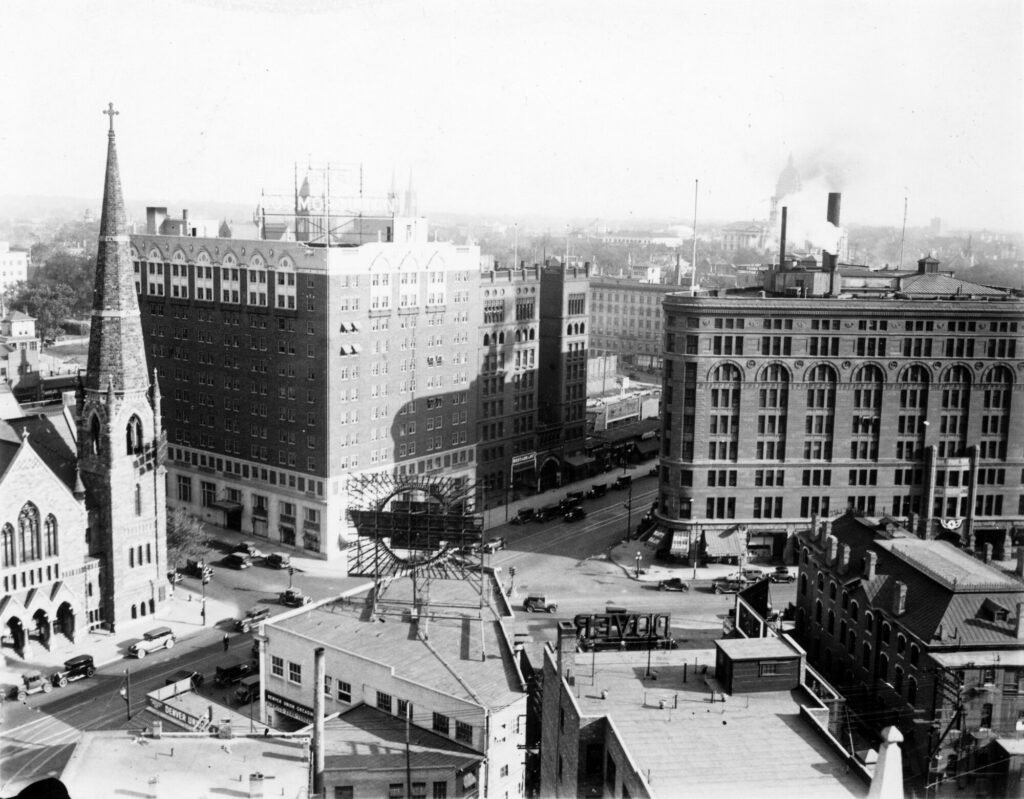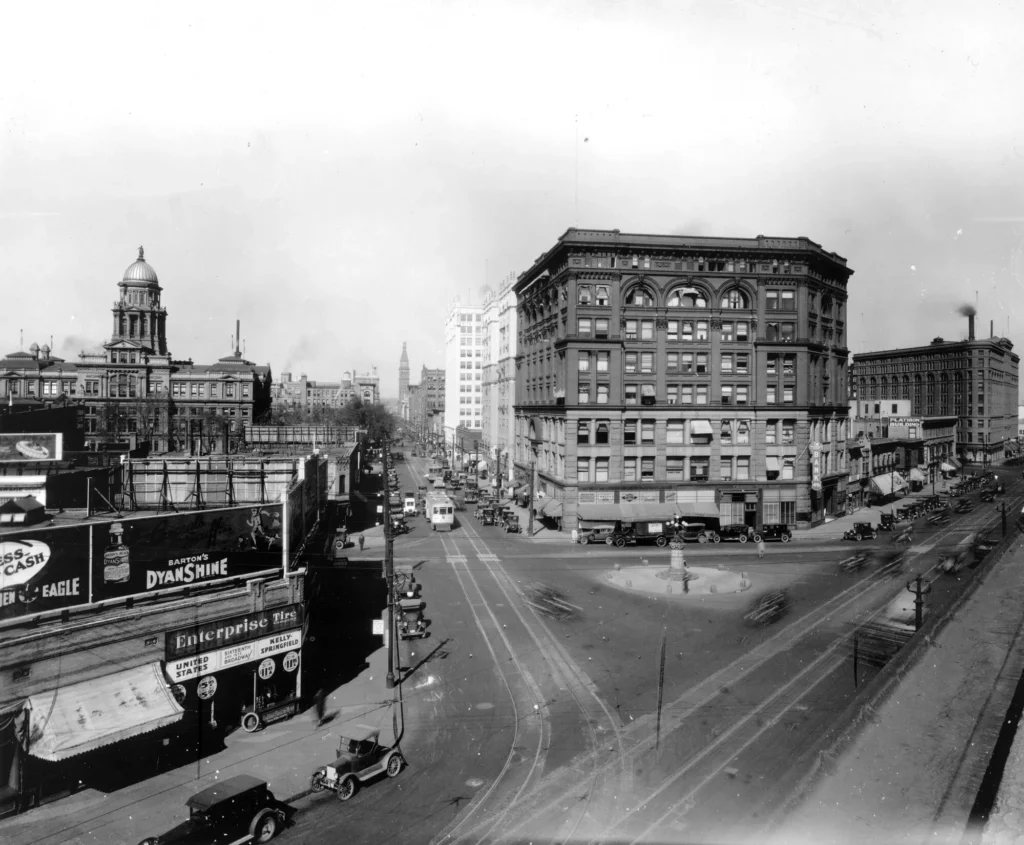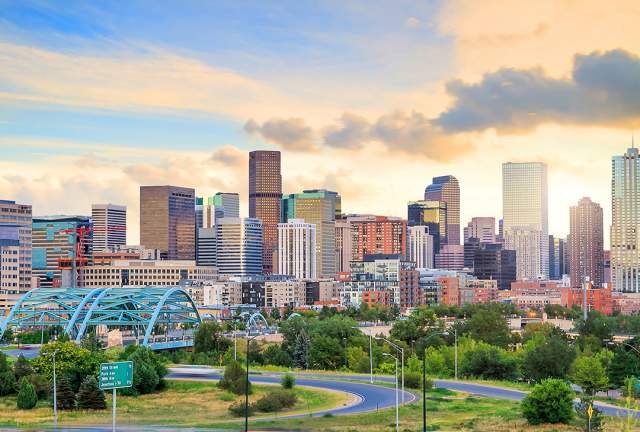Denver Then and Now
Denver Then
Denver, the capital of Colorado, is a dynamic and geographically diverse city located at the western edge of the Great Plains, nestled just east of the majestic Rocky Mountains.
As the only consolidated city-county in the United States, Denver is a unique entity that serves as both a city and a county, offering a seamless administrative structure.
The city’s topography is varied, with its central area consisting of plains, while the surrounding neighborhoods feature hilly terrain to the north, west, and south.
Denver is famously known as the “Mile-High City,” a nickname that reflects its official elevation of 5,280 feet (1 mile) above sea level, which is marked by a benchmark on the steps of the State Capitol building.
The city’s elevation spans from 5,130 to 5,690 feet across its vast expanse.
Covering an area of approximately 99,025 acres, Denver is surrounded by Adams, Arapahoe, and Jefferson counties.

Within the city, there are 78 officially recognized neighborhoods, each of which plays an essential role in the city’s planning and development.
This system of neighborhoods, established in 1970, helps to guide city administration and ensure that each area receives the attention and resources it needs to thrive.
Related Article: Seattle Then and Now
Denver History
Denver’s rich history and evolution as a city are rooted in its early days as a stopping point for Arapaho Indians, fur trappers, and traders.
The city was initially founded during the 1858 gold rush when the towns of Auraria and St. Charles were established along Cherry Creek.
William Larimer, Jr. renamed St. Charles to Denver City in 1858, in honor of the Kansas Territory’s governor, James W. Denver.
The area grew rapidly during the Pikes Peak gold rush and, following the consolidation of Denver City and Auraria in 1860, Denver became the capital of Colorado Territory in 1867.
Related Article: Dallas Then and Now
The city faced several challenges, including fires, floods, and Indian uprisings, but each setback spurred growth and resilience.
As the transcontinental railroad was built through Wyoming, Denver developed its own railway, which connected the city to the Union Pacific and fueled its economic boom.
By the late 1800s, the mining industry, especially silver, brought wealth and prosperity, though the 1893 crash of the silver market threatened to undo the progress.
Through the 20th century, Denver’s economy shifted from mining to more diversified industries, including agriculture, cattle ranching, and food processing.
Related Article: Miami Then and Now

The city became a hub for defense contractors and saw an economic boom following World War II, although the bust in oil prices during the 1980s slowed growth.
Despite these economic fluctuations, Denver rebounded through tourism, high-tech industries, and increasing population, surpassing its 1970s peak by 2000.
The city now serves as a major transportation, industrial, and commercial center, home to several key industries, including telecommunications, aerospace, and financial services.
Its diverse economy also includes a large tourism sector, supported by its outdoor recreation opportunities and numerous cultural attractions.
Related Article: Washington D.C. Then and Now
Denver’s diverse geography, stretching from the plains to the foothills of the Rocky Mountains, provides ample opportunities for outdoor recreation, including skiing, hiking, and mountain biking.
The city’s proximity to these natural resources has made it a popular destination for tourists seeking adventure in the great outdoors.
In addition, Denver boasts a vibrant cultural scene, with world-class museums, performance venues, and sporting teams.
The Denver Museum of Nature and Science, the Denver Art Museum, and the Denver Botanic Gardens offer residents and visitors alike access to a variety of cultural and educational experiences.
Related Article: Boston Then and Now
The city is also known for its professional sports teams, including baseball, basketball, football, and hockey, providing entertainment throughout the year.
Today, Denver continues to be a thriving metropolis, with a population made up of a majority of people of European descent, alongside a growing Hispanic community.
The city faces challenges common to rapidly growing urban areas, including strain on infrastructure, especially in terms of water and transportation systems.
Related Article: San Francisco Then and Now
Traffic congestion and pollution from automobile emissions are ongoing issues, but the city has worked to reduce reliance on cars by expanding its public transit system, such as the light-rail service that opened in 1994.
Despite these challenges, Denver remains a city of great economic, cultural, and environmental significance in the United States, with a bright future ahead as it continues to evolve and adapt to the changing needs of its residents.
Related Article: Panama City Then and Now
Denver Now

Denver is a consolidated city and county that serves as both the capital and most populous city of Colorado.
Located in the western United States, Denver sits in the South Platte River Valley, which lies just to the east of the Front Range of the Rocky Mountains.
This strategic location places the city at the crossroads of the Great Plains and the Mountain West, making it a central hub for both commerce and transportation.
Related Article: Quito Then and Now
With a population of 715,522 as of the 2020 census, Denver is the 19th most populous city in the United States, and it ranks as the fifth most populous state capital.
The city’s growth over the past decade, marked by a 19.22% population increase, reflects its expanding role as a cultural, economic, and metropolitan center for the region.
Founded in 1858 during the Colorado Gold Rush at the confluence of Cherry Creek and the South Platte River, Denver quickly grew from its roots in mining and prospecting into a vibrant commercial center.
Related Article: Santiago Then and Now
Named in honor of James W. Denver, the governor of the Kansas Territory at the time, the city earned the nickname “Mile High City” due to its official elevation of exactly one mile (5,280 feet or 1,609 meters) above sea level.
This elevation is a distinctive feature of Denver, and it adds to the city’s charm and appeal.
Over the years, Denver has expanded beyond its mining origins to become the principal commercial and transportation hub for a large region stretching from the Great Plains to the Rocky Mountain West.
Related Article: Bogota Then and Now
The city is also a key reference point for the Mountain Time Zone, as the 105th meridian west of Greenwich, the longitudinal reference for the time zone, passes directly through Denver Union Station.
As the most populous metropolitan area within a 560-mile radius, Denver is not only a major commercial center but also a vibrant cultural hub.
The city boasts a wide range of cultural institutions, including the Denver Performing Arts Complex, one of the largest of its kind in the country, and the Denver Art Museum, which houses significant collections of Native American and Western art.
Related Article: Lima Then and Now
Denver’s sports scene is also a major draw, with teams in all five major professional leagues: baseball, basketball, football, hockey, and soccer.
The city’s metropolitan area, which includes the cities of Aurora and Lakewood, is home to nearly 3 million people, making it a critical center of economic activity and cultural development in Colorado.
Denver’s favorable weather, with an average of 300 days of sunshine per year, and its proximity to outdoor recreational opportunities in the nearby Rocky Mountains, have contributed to its popularity.
Related Article: Buenos Aires Then and Now
The city’s access to hiking, skiing, and mountain biking makes it a prime location for those who enjoy an active lifestyle.
As a result of its high quality of life, strong job market, and beautiful surroundings, Denver was named the best place to live in the United States by U.S. News & World Report in 2016.
Today, the city continues to grow, attracting new residents and businesses, and maintaining its position as a key player in the region’s cultural, economic, and social landscape.
Related Article: Rio de Janeiro Then and Now
FAQs
Denver is in the United States.
Denver is most known for its nickname “Mile High City” due to its elevation of exactly one mile above sea level, its proximity to the Rocky Mountains, and its vibrant cultural scene, including museums, sports teams, and outdoor activities.
Denver is considered somewhat expensive, especially compared to other cities in Colorado.
Housing and cost of living have risen in recent years, although it’s more affordable than cities like San Francisco or New York.
Denver is in the state of Colorado.






























